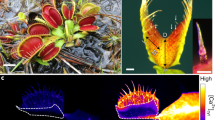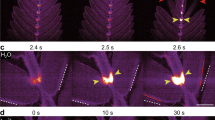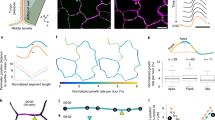Abstract
The rapid closure of the Venus flytrap (Dionaea muscipula) leaf in about 100 ms is one of the fastest movements in the plant kingdom. This led Darwin to describe the plant as “one of the most wonderful in the world”1. The trap closure is initiated by the mechanical stimulation of trigger hairs. Previous studies2,3,4,5,6,7 have focused on the biochemical response of the trigger hairs to stimuli and quantified the propagation of action potentials in the leaves. Here we complement these studies by considering the post-stimulation mechanical aspects of Venus flytrap closure. Using high-speed video imaging, non-invasive microscopy techniques and a simple theoretical model, we show that the fast closure of the trap results from a snap-buckling instability, the onset of which is controlled actively by the plant. Our study identifies an ingenious solution to scaling up movements in non-muscular engines and provides a general framework for understanding nastic motion in plants.
This is a preview of subscription content, access via your institution
Access options
Subscribe to this journal
Receive 51 print issues and online access
$199.00 per year
only $3.90 per issue
Buy this article
- Purchase on Springer Link
- Instant access to full article PDF
Prices may be subject to local taxes which are calculated during checkout




Similar content being viewed by others
References
Darwin, C. Insectivorous Plants (Murray, London, 1875)
Burdon-Sanderson, J. On the electromotive properties of the leaf of dionaea in the excited and unexcited states. Phil. Trans. R. Soc. Lond. 173, 1–55 (1882)
Stuhlman, O. Jr & Darder, E. B. The action potentials obtained from Venus's-flytrap. Science 111, 491–492 (1950)
Hodick, D. & Sievers, A. The action potential of Dionaea muscipula Ellis. Planta 174, 8–18 (1988)
Hodick, D. & Sievers, A. On the mechanism of trap closure of Venus flytrap (Dionaea muscipula Ellis). Planta 179, 32–42 (1989)
Sibaoka, T. Physiology of rapid movements in higher plants. Annu. Rev. Plant Physiol. 20, 165–184 (1969)
Juniper, B. E., Robins, R. J. & Joel, D. M. The Carnivorous Plants (Academic, London, 1989)
Williams, S. E. & Bennet, A. B. Leaf closure in the Venus flytrap: an acid growth response. Science 218, 1120–1122 (1982)
Stuhlman, O. A physical analysis of the opening and closing movements of the lobes of Venus' flytrap. Bull. Torrey Bot. Club 7, 22–44 (1948)
Ashida, J. Studies on leaf movement of Aldrovanda vesiculosa . Mem. Coll. Sci. Kyoto Imp. Univ., Ser. B 9, 141–244 (1934)
Morillon, R., Liénard, D., Chrispeels, M. J. & Lassalles, J.-P. Rapid movements of plants organs require solute-water cotransporters or contractile proteins. Plant Physiol. 127, 720–723 (2001)
Brown, W. H. The mechanism of movement and duration of the effect of stimulation in the leaves of dionaea. Am. J. Bot. 3, 68–90 (1916)
Hill, B. S. & Findlay, G. P. The power of movement in plants: the role of osmotic machines. Q. Rev. Biophys. 14, 173–222 (1981)
Love, A. E. H. A Treatise on the Mathematical Theory of Elasticity 4th edn (Dover, New York, 1944)
Biot, M. A. General theory of three-dimensional consolidation. J. Appl. Phys. 12, 155–165 (1941)
Skotheim, J. M. & Mahadevan, L. Dynamics of poroelastic filaments. Proc. R. Soc. Lond. A 460, 1995–2020 (2004)
Frensch, J. & Steudle, E. Axial and radial hydraulic resistance to roots of maize (Zea mays L.). Plant Physiol. 91, 719–726 (1989)
Dumais, J. & Kwiatkowska, D. Analysis of surface growth in shoot apices. Plant J. 31, 229–241 (2002)
Green, P. B., Havelange, A. & Bernier, G. Floral morphogenesis in Anagallis: Scanning-electron-micrograph sequences from individual growing meristems before, during, and after the transition to flowering. Planta 185, 502–512 (1991)
Mansfield, E. H. The Bending and Stretching of Plates 2nd edn (Cambridge Univ. Press, Cambridge, 1989)
Acknowledgements
We thank F. Shindler for the illustrations in Fig. 2. We acknowledge support via the Norwegian Research Council (J.M.S.) and the Schlumberger Chair Fund (L.M.) at Cambridge University, where this work was begun and primarily done.
Author information
Authors and Affiliations
Corresponding author
Ethics declarations
Competing interests
The authors declare that they have no competing financial interests.
Supplementary information
Supplementary Video
Kinematic measurements of snapping were carried out on videos filmed at 400 frames s-1. Here we show a representative video of leaf closure filmed at the slightly lower speed of 125 frames s-1 and played back at 30 frames s-1. (MOV 5597 kb)
Supplementary Methods
This section includes (a) details of the strain-field measurement technique, (b) experiments and results regarding the response of the leaf tissue to impulsive and step loads, (c) details of our poroelastic model for the dynamics of leaf closure, and (d) a summary of our notation. (DOC 68 kb)
Supplementary Figure 1
This figure presents typical measurements of the local strain field associated with leaf closure, determined using the replica technique. (PDF 2319 kb)
Supplementary Figure 2
This figure shows the response of a strip of the closed leaf to impulse and step loads. The results are consistent with the simple estimate of the inertial and relaxation times in the main text of the paper. (PDF 408 kb)
Rights and permissions
About this article
Cite this article
Forterre, Y., Skotheim, J., Dumais, J. et al. How the Venus flytrap snaps. Nature 433, 421–425 (2005). https://doi.org/10.1038/nature03185
Received:
Accepted:
Issue Date:
DOI: https://doi.org/10.1038/nature03185
This article is cited by
-
Self-regulated reversal deformation and locomotion of structurally homogenous hydrogels subjected to constant light illumination
Nature Communications (2024)
-
Bioinspired strategies for biomimetic actuators from ultrafast to ultraslow
Nano Research (2024)
-
Regulating photosalient behavior in dynamic metal-organic crystals
Communications Chemistry (2023)
-
A palisade-shaped membrane reservoir is required for rapid ring cell inflation in Drechslerella dactyloides
Nature Communications (2023)
-
Membrane compression by synaptic vesicle exocytosis triggers ultrafast endocytosis
Nature Communications (2023)
Comments
By submitting a comment you agree to abide by our Terms and Community Guidelines. If you find something abusive or that does not comply with our terms or guidelines please flag it as inappropriate.



